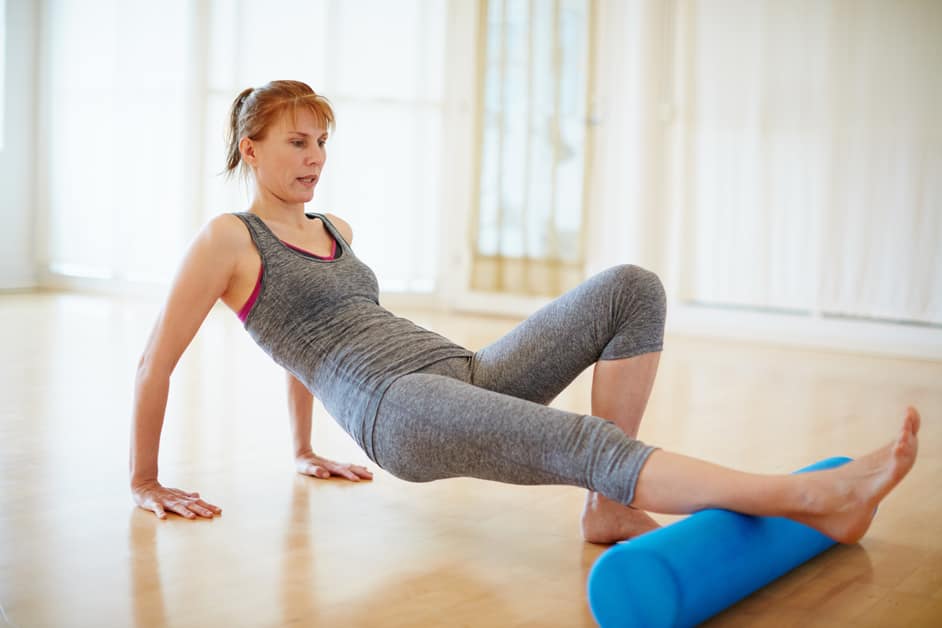Introduction
Foam rolling is an SMR (self-myofascial release) technique. It works by applying pressure to certain body areas to reduce pain and tension. It is part of a knee strengthening program.
Using foam rolling together with other strengthening exercises can target the muscles around the knee joint. Stretches and squats help improve flexibility, strength and range of motion. Using these along with foam roller techniques can decrease aches and pains in the lower body post physical activity.
This guide explains how to use a foam roller for knee strengthening exercises. It can help alleviate tightness in muscles that support the knee joint, such as hip flexors, hamstrings and quadriceps. Foam rolling also increases blood flow, aiding the healing process after exercise or injury.
Benefits of Foam Rolling
Foam rolling is a great self-massage technique. It warms up muscles before a workout, releases tightness throughout the body, and improves joint mobility. It also enhances balance and proprioception by activating deeper muscle layers and joint stabilization. This can decrease pain in joints, like the knee.
Benefits of Foam Rolling:
- Improves circulation to injured area: Foam rolling activates motor neurons in nearby muscles, reducing inflammation and increasing circulation. This can promote faster recovery.
- Enhances flexibility: Foam rolling deeply releases tension in muscles, leading to improved flexibility in leg muscles and other structures.
- Increases muscular strength: Foam rolling has been proven to invoke higher levels of muscle activation than static stretching, which can improve strength in upper thigh muscles that support the knees.
What You Will Need
You’ll need specific items for your foam rolling and knee strengthening exercises. Get a foam roller, stretching bands, a 1-2 lb hand weight or dumbbell, and a chair or exercise bench. Muscle rub can improve circulation before and after your sessions. Make sure you’re warmed up to avoid any injuries.
Gather your supplies. Put the foam roller on the ground or floor. Position yourself with the roller beneath your knee. Hold the roller with both hands. Roll up and down from the knee and below. Do this 10-15 times per leg.
Using different foam roller widths increases difficulty levels and stimulates more muscles around the knee joint area. With regularity, these exercises should strengthen your knees naturally!
Foam Rolling Exercises
Foam rolling is a cinch to do and is useful for relieving muscle tension and improving mobility and joint strength. It’s an essential part of taking care of yourself! Foam rolling can support healthy knee function by strengthening the muscles around the knee joint.
We’ll walk you through the basics of foam rolling and give you some simple knee-strengthening exercises to try.
Calf Roll
The calf roll is great for stretching and strengthening the knee complex. It can help lessen tension in your calves and shin muscles – this could lead to improved joint mobility.
For the calf roll, put your foam roller below your calf muscle, close to the ankle joint. Support yourself with your arms, then move your body in clockwise and counterclockwise circles. Do this 10 times in each direction. Breathe deeply all throughout the exercise for maximum tension relief.
If you want more intensity, add pressure by putting your body weight onto the foam roller. Move it up and down your lower leg slowly to target knots of deep-seated tension in the calf muscle group. Concentrate on areas that are tender or painful, or spots that take longer for you to relax into.
Hamstring Roll
Hamstring rolling is a great self-massage technique. It can help improve flexibility and cause relaxation in the hamstrings.
Start by placing a foam roller under your thighs, just above your knees. Engage your core muscles, draw your shoulder blades down and together. Cross your arms over each chest. On an exhale, roll up and down the length of your hamstrings. This is from just above the knee up to the gluteus muscles. Keep pressure on only one side at a time. Gradually, allow more pressure on painful areas. Spend extra few seconds here for newfound flexibility.
Here are the steps for hamstring rolling:
- Keep pressure on only one side at a time.
- Gradually, allow more pressure on painful areas.
- Spend extra few seconds here for newfound flexibility.
- Each leg should take no more than two minutes.
- If pain results, communicate with your body. Remove pressure or discontinue if necessary.
Quad Roll
Quad rolling is essential in any foam roller exercise! Lie on your back with one leg on the foam roller. Bend or straighten your knee. Roll up and down each side of the muscle for 30-60 secs, focusing on tight and uncomfortable areas. Keep your abs activated throughout the exercise. As mobility gets better, focus further into these areas to break up adhesions and scar tissue.
When finished, move onto the other leg. Then proceed to more exercises.
Glute Roll
Do glute roll exercises to engage and strengthen your glutes. This will help with better posture and activities like running.
- Sit on the floor. Bend your knees and put your feet flat on the ground.
- Place the foam roller under your glutes, between your right hipbone and pelvis.
- Roll up and down slowly and steadily, for 18-20 seconds. Engage your core and stay centered on the roller.
- If you find any tight or tender spots, hold them while rolling out tension.
- Once done with one side, switch to the other. Do both sides for a balanced workout.
Hip Flexor Roll
The hip flexor roll is great for targeting the muscles around your upper thighs and hips. Start by lying face down on a foam roller. Place it perpendicularly along your lower back and hips. Have both feet flat on the ground, with one leg slightly higher. Roll your body forward and backward. Feel the foam roller working against your hip flexors.
To make it harder, hold each roll for 10 seconds or use your whole bodyweight. Doing this exercise often can improve flexibility in your glutes, quads, knees, and hip joints.
IT Band Roll
The iliotibial (IT) band is a strong connective tissue. It runs down the outside of your thigh, from the hip to the knee. It helps keep the knee joint stable.
The foam roller can help strengthen the IT Band. This technique is called self-myofascial release, or SMR.
To do the IT Band Roll:
- Start in a plank position, with both hands on the foam roller. Place one foot in front of the other, in a runner’s lunge position.
- Roll back and forth slowly, near the IT band.
- Hold any tender spots for 10-20 seconds. Do three sets of 10-20 rolls on each side.
- Use only light pressure at first. Increase pressure and duration carefully. Take deep breaths throughout.
Knee Roll
The knee roll is a foam rolling exercise that strengthens muscles in the knee and lower leg. It’s suitable for people of all fitness levels; from those recovering from knee injuries, to athletes warming up. Foam rolling helps stretch tight muscles, which can improve motion and performance.
To do the knee roll, lie on one side and place the foam roller just below the kneecap. To make it more comfortable, fold a towel into thirds and put it under your leg. Use your legs to roll back and forth, applying light pressure with your hands. Spend 10-30 seconds in each spot, depending on how uncomfortable it is. Look for spots that are tight or tender, as these areas need attention.
Finally, put one foot against a wall and press down lightly with both hands on top of your calf area. Hold for 30-60 seconds until you feel relief. Take caution when performing this exercise, as sustained pain or swelling can indicate an injury. Stop immediately if this happens – consult a doctor before continuing with any exercises.
Conclusion
Warm up with some dynamic stretches like leg swinging and hip opening movements before beginning your foam roller session. After that, move on to the static exercises targeting specific muscle groups. Once you’re done, cool down and take a few minutes of rest or do some additional stretches if you feel like it.
Consistency is key when it comes to strengthening routines. To improve your range of motion and functioning of your knee joint, stick with these exercises on a regular basis.
By following the foam roller exercises for knee strengthening discussed here, you’ll experience improved strength and mobility in your knee joints. Feel free to modify them for your level of experience.
We wish you success in your overall wellness journey!
Frequently Asked Questions
Q: What is a foam roller?
A: A foam roller is a cylindrical piece of foam that is used to help improve flexibility and muscle soreness. It can also be used to perform strengthening exercises for the knees.
Q: How do I use a foam roller for knee strengthening exercises?
A: To use a foam roller for knee strengthening exercises, start by lying down on the foam roller with one knee on the roller and the other leg bent at a 90-degree angle. Slowly roll back and forth, focusing on the muscles around the knee. Do this for several minutes, then switch legs and repeat.
Q: How often should I use a foam roller for knee strengthening exercises?
A: Foam rolling for knee strengthening exercises should be done 2-3 times a week. It is important to take breaks in between foam rolling sessions to allow the muscles to recover and rebuild.





